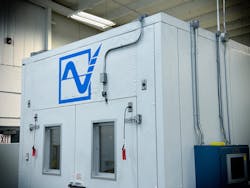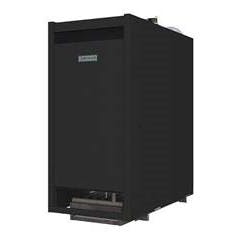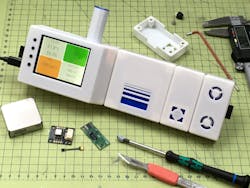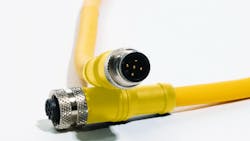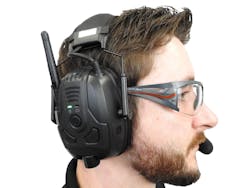Product Updates: Certifications, Regulations, Validations
Pfannenberg Qualifies for UL’s Data Acceptance Program
Pfannenberg, Inc.'s test lab has been assessed and found to comply with the requirements of ISO/IEC 17025 in accordance with UL’s Data Acceptance Program (DAP) and has been qualified as a DAP participant in the Client Test Data Program (CTDP) for the testing and certification of special purpose air conditioning systems.
CTDP certification is awarded to companies that demonstrate the highest levels of quality management, laboratory testing capability, technical expertise, and knowledge of industry standards. UL reassesses CTDP certification annually.
The CTDP certificate enables Pfannenberg to perform testing in its own laboratory, equivalent to the testing that UL performs. UL thoroughly reviews all data submitted by the lab before issuing the UL Mark certification. CTDP certification significantly shortens the turnaround time for UL Mark certification, improving the speed to market for Pfannenberg's new products and enhancements.
The Pfannenberg lab performs a wide range of tests critical to analyzing the performance and safety of air conditioning systems, including Computational Fluid Dynamics Analysis, as well as environmental simulations, a climatic chamber, and IP protection class tests. The lab also performs transport and vibration tests and EMC/noise emission tests.
Weil-McLain Boiler Product Lines Meet New U.S. DOE Regulations
Weil-McLain has launched its 2023 DOE-compliant commercial cast iron product portfolio with enhanced boiler efficiencies. The upgraded designs of the LGB Steam/Water Series 3 and 88 Water Series 3 boiler product lines include new features that go beyond regulatory compliance for performance, reliability, and service life.
DOE regulation 431.87 states that commercial boilers manufactured after January 9, 2023, including knockdown, assembled block, and complete package configurations, must meet higher minimum efficiency standards. The LGB family meets those requirements with enhanced thermal efficiencies of up to 84% and combustion efficiencies of up to 81%. Additionally, the 88 product family has thermal efficiencies of up to 87% and combustion efficiencies of up to 88%.
“Increasing the efficiency of the LGB and 88 Water families results in lower fuel consumption and operating costs while providing reliable and trouble-free operation for property owners and facility managers.” — John Miller, commercial boiler product manager, Weil-McLain.
Ideal for light commercial applications, the LGB is Weil-McLain’s highest-efficiency commercial cast iron atmospheric gas boiler and is available in steam and water heating designs ranging from 350 to 2,470 MBH. Tested for 80 psi working pressure, the boiler includes factory-assembled bases and natural draft burners for quick and easy installation and features an improved plug-and-play wiring approach, easy start-up programming prompts, and an LCD backlit digital display. An exhaust gas draft inducer reduces overhead height requirements and enables a compact boiler installation, allowing for more piping and venting headroom.
The 88 Series offers a performance range of 960 to 5,845 MBH and is suited for many of the same commercial applications as the LGB line. Available in steam or water boiler configurations with gas, oil, and gas-oil fuel options from a broad range of power burner vendors, standard features include a combination pressure and temperature gauge, HXT-bars for optimized heat transfer, low-water cutoff, 30 psi working pressure, and observation ports at the front and back for quick inspection.
Customers can also anticipate a DOE-compliant 94 Steam Series 4 boiler model targeted for the middle of the year.
Mactac Minneapolis Manufacturing Site Earns ISO 9001:2015 Certification
Mactac's manufacturing site in Minneapolis has earned ISO 9001:2015 quality management certification.
The ISO 9001 certificate is the world's most recognized international certification standard for a quality management system. It provides guidance for companies that aim to ensure products and services consistently meet quality requirements.
As an ISO 9001:2015 certified site, Mactac Minneapolis has a systematic quality management system in place and is committed to cost and waste reduction, continuous improvement, regulatory compliance, and more.
Consistently meeting the needs and expectations of customers, the Mactac quality management system follows standardized policies and processes. It incorporates comprehensive review and measurement processes, a rigorous improvement process, robust corrective action processes when needed, and ongoing customer feedback.
The Mactac Minneapolis site, at 72,000 square feet, is the latest Mactac facility to earn recognition. Mactac also holds the ISO 9001:2015 certificate at its Columbus, IN, and Scranton, PA. sites.
RS Sensor Development Kit Certified by Open-Source Hardware Association
RS Group announced that its DesignSpark Environmental Sensor Development Kit (ESDK) has been certified by the Open-Source Hardware Association (OSHWA). Open-source hardware is a term for physical objects whose design has been released to allow anyone to make, modify, distribute, and use.
The aims of the OSHWA are to foster technological knowledge and encourage research that is accessible, collaborative, and respects user freedom. The certification recognizes that the kit meets a uniform and well-defined standard for open-source compliance and provides users with the knowledge that the definition of open-source hardware used by a specific project matches the community definition of open-source hardware. It also creates a legally binding and unique logo that can only be used by projects that comply with the community definition.
Developed as part of RS DesignSpark’s #ActivistEngineering campaign, the ESDK is an advanced open-source and cloud-connected platform that makes it easy to prototype custom sensor-based solutions. RS DesignSpark is a fast-growing online community for engineers that offers a suite of design tools, development kits, such as the ESDK, comprehensive 2D/3D and electronics part libraries, and a host of design resources including technical articles, projects, and community forums.
Use of the DesignSpark ESDK has supported DesignSpark members in designing projects such as the Breathe Better Bear and The Good Air Canary, two typical projects that have been developed based on the capabilities of the ESDK for air quality measurement. The ESDK can also be deployed in many other scenarios, including a host of IoT applications that have a need for a small Linux computer with an integrated touchscreen and GPS capability.
DesignSpark has made all the design project files for the ESDK available free of charge at https://github.com/DesignSparkRS/ESDK
Components Express Receives UL Listing for New Cable Assemblies
Components Express, Inc. has received the UL listing for its new line of M12 cable assemblies.
The cable assemblies come in standard lengths up to 50 feet (15 meters), with a variety of male–female and flying lead connector combinations on either end. They also feature PVC jacketing in a variety of colors, as well as 4 to 17-pin options.
Phosphorus Launches IoT Security Capabilities To Catch Devices Banned by the FCC
Phosphorus, a provider of proactive and full-scope security for the extended Internet of Things (xIoT), has released new security features that enable organizations to discover and monitor their networks for the presence of xIoT devices that the U.S. government deems a significant security risk. The new features also include the capability to remotely disable and remove the devices from the network.
The security update follows the FCC’s ban on the sale or importation of devices made by several Chinese manufacturers that it considers to pose “an unacceptable risk to the national security of the U.S. or the security or safety of U.S. persons.” The Covered List includes video surveillance and telecommunications equipment produced by Huawei Technologies, ZTE Corporation, Hytera Communications, Hangzhou Hikvision Digital Technology, and Dahua Technology (and their subsidiaries and affiliates).
“The Phosphorus xIoT Security Platform is the industry’s only solution that can discover the presence of these prohibited devices and remotely render them inert at scale,” said John Vecchi, Chief Marketing Officer at Phosphorus. “These unique capabilities will empower enterprises and government organizations across the U.S. to discover, disable, and remove banned or potentially dangerous devices from their enterprise environments.”
The platform can discover xIoT assets and it's the only platform able to communicate with these devices (ranging from security cameras to PLCs) in their native languages. This enables a high degree of accuracy, granularity, and speed when discovering and analyzing these devices to create comprehensive inventories of xIoT assets that include device type, brand, model, firmware version, credential status, default/enabled protocols, certificate status, and more.
Organizations have direct control over every single device in their wide-ranging xIoT deployments; organizations can update and rotate a device’s credentials, manage firmware, disable remote services, turn off unnecessary connectivity features, check for valid certificates, and reboot the device.
Blackline Safety Announces First BS8484:2022 Certified Gas Detector (UK)
G7c personal wearable by Blackline Safety is the world’s first connected gas detector and lone worker safety monitor certified to the newly-upgraded BS 8484:2022.
BS 8484:2022 defines the industry-leading code of practice for lone worker equipment and monitoring services in the UK. The BS 8484:2022 standard underpins the UK’s safety leadership by providing lone worker product and service providers with a code of practice that allows the despatch of a police Level 1 response.
Lone workers are those who work by themselves without close or direct supervision. Lone Worker monitors enable organizations to maximize workers’ safety with incident detection and emergency response services to ensure most vulnerable team members are always accounted for and return home safely at the end of each working day.
The all-in-one cloud-connected solution integrates 4G connectivity and industry-first capabilities to enable efficient and reliable lone-worker monitoring. The risk that an employee's call for help could go unanswered is mitigated by connecting workers directly with live monitoring personnel, from wherever they're working.
BS8484 enables certified service suppliers to offer the highest level of emergency response, bypassing the central 999 system to make the process as efficient as possible.
G7c’s lifesaving man-down and lone worker protection features include:
- Integrated connectivity wirelessly links your team to live monitoring personnel
- True Fall Detection and no-motion alerts
- Missed check-ins immediately identify when a team member fails to confirm their safety status within a scheduled timeframe
- Reliable communication with two-way text messaging, two-way voice calling, and push-to-talk options
- G7c’s emergency SOS latch generates an instant visible and audible alarm, alerting monitoring personnel should a worker be faced with a threatening or dangerous situation
- The Silent SOS feature enables users to discreetly call for help by pressing the red latch for three seconds so there are no obvious signs of activation to an aggressor. G7c automatically communicates man-down and gas alerts to monitoring personnel who are equipped to deploy a potentially life-saving emergency response when and wherever needed, up to and including the police.
Connectivity is necessary to ensure the fastest possible emergency response. The live monitoring team follows tailored emergency response protocols and when required, escalates to the highest levels of police, ambulance or fire service, only permissible when using a BS 8484:2022 certified solution.
G7c is the only BS 8484:2022-certified combination lone worker monitoring and gas detection product currently on the market.
JLT VERSO Series Validated as Navis Ready for the Latest Navis N4 TOS
JLT Mobile Computers' VERSO Series of vehicle-mounted terminals (VMTs) has passed Navis Ready Validation for the latest version of the Navis N4 terminal operating system (TOS). The validation reinforces the fact that the JLT VERSO Series—specifically developed for use in the harshest conditions—is an ideal mobile IT platform for demanding port operations.
Navis is a premier brand from Kaleris for best-in-class port, terminal, carrier, and vessel solutions. Kaleris, a leading provider of cloud-based supply chain execution and visibility technology solutions, offers a global platform that unlocks operating data, connects workflows, and increases visibility to improve the entire shipment lifecycle. Navis brand technology plays a key role by linking the busiest nodes in the global supply chain to the Kaleris platform.
This revalidation is a continuation of JLT's long-term partnership with the Navis Ready Program that began in 2015 and was reinforced in 2019 when JLT became the first hardware provider to ensure that its computers for the port segment would be validated for use with major upcoming Navis releases for the following five years. This gives customers an extra level of security and confidence when purchasing JLT terminals for their Navis system.
According to the Navis report: “This [validation] ensures customers can buy and engage with vendors with confidence knowing that the majority of the integration work has been completed. The information provided in the Navis Ready Validation report helps customers assess the level of integration achieved and what is possible with a vendor.”
Navis Ready Partner Program is a validation testing program that is open to vendors supplying handheld devices and other hardware technologies within a marine container terminal operating environment. The program ensures that a vendor’s hardware and system responses have been tested and that they have integrated with specific versions of the Navis N4 terminal operating system (TOS) in an integration environment.
Cardo Crew Awarded Highest PPE Certification for Headset
Powered both by Bluetooth and by Cardo’s proprietary Dynamic Mesh Communications (DMC) technologies, Cardo Crew’s Comm-Set is now certified as having the comprehensive hearing protection classification in its class for PPE. Comm-Set provides the most advanced wireless communication technology on the market today.
Comm-Set wireless mesh headset has improved the way teams on the go interact with increased safety, reliability, and performance. This PPE headset was designed and developed for professional teams: arborists/tree care, construction, industrial, first responders, commercial or residential landscape teams, or any professional teams that require reliable communication in challenging job sites or environments.
Comm-Set achieved the following results and is recognized for its full PPE certification across these global continents.
- Signal-to-Noise Ratio (SNR, Europe): 32 dB for Headband, 29 dB for Helmet-Mount.
- Noise Reduction Rating (NRR, USA): 26 dB for Headband, 23 dB for Helmet-Mount.
- CSA (Canada): Class AL (highest) for both Headband and Helmet-Mount.
- AS/NZS* (Australia/New Zealand): 30 dB, Class 5 for Headband, 26 dB, Class 5 for Helmet-Mount (*tested and fully complied by an accredited lab).
Comm-Set’s situational awareness capability feature automatically reduces impulse noises while allowing ambient noise, including amplification of the human voice to come through, which is perfect for risky situations.
Comm-Set underwent thorough testing against the European EN-352 standard, in three classifications:
About the Author
Laura Davis
Editor-in-Chief, New Equipment Digest
Laura Davis is the editor in chief of New Equipment Digest (NED), a brand part of the Manufacturing Group at EndeavorB2B. NED covers all products, equipment, solutions, and technology related to the broad scope of manufacturing, from mops and buckets to robots and automation. Laura has been a manufacturing product writer for eight years, knowledgeable about the ins and outs of the industry, along with what readers are looking for when wanting to learn about the latest products on the market.

